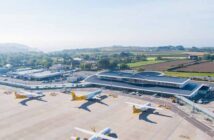Łódź Władysław Reymont Airport, located just 6 kilometres southwest of Łódź’s city centre, offers a compact and efficient experience for travellers. Serving around 400,000 passengers annually, this regional airport connects to a handful of European destinations like London Stansted, Dublin, and Alicante, primarily through low-cost carriers such as Ryanair and Wizz Air. Its small scale and straightforward design make it an appealing choice for those seeking a hassle-free journey.
Accessing the airport is quick and convenient, with multiple transport options linking it to central Łódź. The 65A and 65B bus lines provide direct service from the city centre, stopping right outside the passenger terminal in approximately 25 to 30 minutes, with fares as low as 4.40 złoty for a 20-minute ticket, which currently extends to 40 minutes due to temporary roadwork adjustments. Passengers can board at stops like Piotrkowska Centrum, though a tram transfer may be needed depending on the starting point. The Jakdojade app simplifies ticket purchases and route planning, offering English-language options and card payments.
Taxis, available at a rank directly outside the arrivals gate, take about 15 to 20 minutes to reach the city, costing around 30 złoty. Reliable operators like Green Cab or Taxi 400 400 accept card payments, and pre-booking through hotels is recommended. For drivers, a large, affordable car park sits adjacent to the terminal, with online booking available and rates starting at 30 złoty per day.
The airport’s single terminal, opened in 2012 with a capacity for 1.5 to 2 million passengers, is designed for simplicity. The ground floor houses arrivals and departures, connected by a short corridor, with 14 check-in desks and five departure gates split between Schengen and non-Schengen areas. A small upstairs area features a free observation deck for plane spotting, alongside baby-changing facilities. The compact layout ensures quick navigation, with minimal walking distances and no need for shuttles.
Security is typically swift, with most passengers clearing in under 15 minutes, though peak morning or evening hours, when flights cluster, can lead to brief queues due to limited staffing or single-flight processing. Travellers are advised to arrive two hours early to account for these potential bottlenecks.
Dining and retail options are modest but practical, catering to essential needs. Airside, passengers can grab a coffee or snack at The Coffee House or Flying Bistro, while 1Minute offers quick bites like sandwiches. Landside, a small bistro with a terrace serves light meals, ideal for enjoying on pleasant days. Retail includes a duty-free shop airside with cosmetics, alcohol, and souvenirs, and a convenience store on the landside for travel essentials. A WHSmith outlet provides books and snacks, though prices are higher than in the city, so budget-conscious travellers may prefer to shop beforehand. The limited selection reflects the airport’s low traffic, ensuring a calm atmosphere but fewer choices than larger hubs.
Facilities are functional and traveller-friendly, with free Wi-Fi available via the “LodzAirport” network and five charging stations located both landside and airside. Toilets, including accessible ones, are well-maintained, and a lift ensures easy access to the upper floor. For passengers with reduced mobility, the airport offers wheelchair assistance and a dedicated MyWay service, bookable in advance. The VIP Lounge, accessible for a fee, provides snacks, drinks, and showers, though food options are basic. A car rental corridor near arrivals features operators like Avis and Hertz, and an ATM is available for cash needs. The observation deck and a celebrity photo gallery add a unique touch, though the upper floor is otherwise sparsely used.
On-time performance is generally reliable, with the airport’s low flight volume—handling just two to four daily flights—minimising congestion. Delays, when they occur, are often due to weather conditions, particularly fog or strong winds, given the airport’s central Polish location. Airline-specific issues, such as technical faults or air traffic control delays, can also impact schedules, especially for low-cost carriers with tight turnarounds. Real-time updates are available via in-terminal displays or apps like Flightradar24, and passengers are encouraged to check statuses regularly.
Connections at Łódź Airport are limited, as it primarily serves point-to-point routes rather than acting as a transfer hub. The single-terminal layout makes any necessary gate changes quick, with minimal walking and clear signage. However, with no domestic flights and a focus on budget carriers, passengers needing onward connections may need to travel via larger airports like Warsaw Chopin, 120 kilometres away, accessible by FlixBus or train in about two hours. Those with tight schedules should plan ample layover time, as low-cost airlines may not accommodate missed connections.
Potential delays are typically linked to external factors like weather or air traffic control, but the airport’s small size can amplify operational hiccups, such as delayed baggage handling or check-in desk openings, particularly during peak hours. Travellers should monitor flight updates and allow extra time during morning or evening rushes to ensure a smooth departure.




